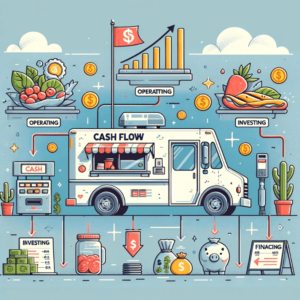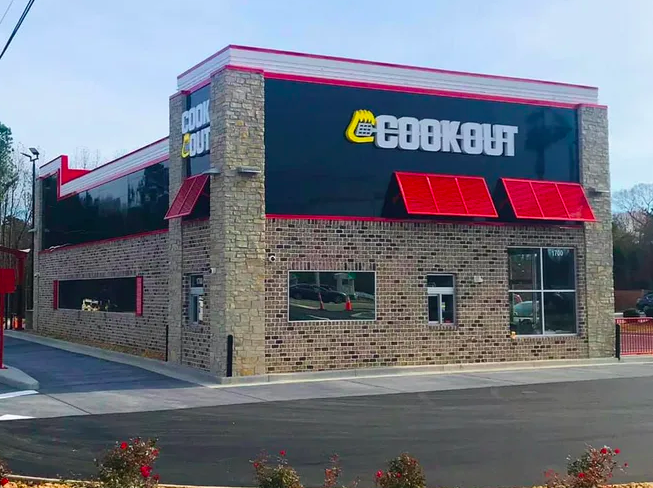Even though it may be at the end of your food truck business plan, your food truck financial expenses are in the financial plan section is the section that determines whether or not your mobile food business idea is viable. This helps you and prospective investors determine if this food truck will be a good investment.
In basic terms, the financial plan section of a food truck business plan consists of three separate financial statements:
- income statement
- cash flow projection
- balance sheet
You will also have to provide a brief explanation or analysis of these three statements to include in the business plan. I’ve provided examples on how to create each of these drawn from my own experience owning a hot dog truck.
First, however, you need to put together some of the financial data you’ll need by examining your food truck financial expenses.
Page Contents
Food Truck Financial Expenses
You need to look at your food truck financial expenses as broken into two categories; the food truck start-up expenses and the food truck operating expenses.
All the costs of getting your food truck up and running go into the start-up expenses category.
Food Truck Start-Up Expenses:
- business registration fees
- business licensing and permits
- starting inventory
- commissary rent deposits
- down payments on kitchen equipment
- food vendor account set up fees
Unfortunately, these are just a sampling of a food truck’s start-up expenses; your own list will probably expand as soon as you start writing them down. Learn more about the costs to start a food truck.
The second category food truck business expenses are the operating expenses. These are the costs of keeping your food truck business running. Think of these as the things you’re going to have to pay each month.
Food Truck Operating Expenses:
- salaries (yours and staff salaries)
- rent payments
- vehicle lease payments
- telecommunications
- fuel costs (truck and generator)
- propane
- raw ingredients
- storage
- promotion
- loan payments
- office supplies
- vehicle and equipment maintenance
Once again, this is just a partial list to get the prospective food truck owner started. Once you have your operating expenses list complete, the total will show you what it will cost to keep your food truck business on the road and operating each month.
Multiply this number by 6, and you have a six month estimate of your operating expenses. Now add this to the total of your start-up expenses list, and you’ll have a ballpark figure for your complete start-up costs.

Food truck cashflow.
Sample Income Statement
Creating an income statement for your hot dog cart is like keeping a detailed diary of your business’s money matters over a certain period, usually a year. It shows you exactly how much money you made from selling hot dogs and other items, how much you spent to keep the cart running, and what’s left as your profit.
This detailed income statement provides at the financial performance of the hot dog truck business over one year. It breaks down revenue into specific sources, details the costs associated with goods sold, and itemizes operating expenses to give a clear picture of where money is being spent. The bottom line, or net income after taxes, shows the profitability of the business after all expenses, including taxes, have been accounted for.
| Category | Description | Amount (USD) |
|---|---|---|
| Revenue | Gross Sales – Hot Dog Sales | $130,000 |
| Gross Sales – Beverage Sales | $30,000 | |
| Gross Sales – Merchandise Sales | $20,000 | |
| Total Revenue | $180,000 | |
| Cost of Goods Sold (COGS) | Hot Dogs and Ingredients | $40,000 |
| Beverages | $10,000 | |
| Merchandise Cost | $8,000 | |
| Total COGS | $58,000 | |
| Gross Profit | $122,000 | |
| Operating Expenses | Salaries and Wages | $45,000 |
| Rent and Utilities | $12,000 | |
| Fuel and Maintenance | $7,000 | |
| Marketing and Advertising | $9,000 | |
| Insurance | $6,000 | |
| Supplies and Miscellaneous | $5,000 | |
| Depreciation | $4,000 | |
| Total Operating Expenses | $83,000 | |
| Net Income Before Taxes | Earnings Before Interest and Taxes (EBIT) | $39,000 |
| Taxes | Estimated Taxes (20%) | $7,800 |
| Net Income | Net Income After Taxes | $31,200 |
Here’s why this section is super helpful to food truck owners:
- Track Performance: It helps you see how well your business is doing. Are you making more money than you’re spending? Is your hot dog cart as profitable as you hoped?
- Make Smart Decisions: With this information, you can decide if you need to change anything, like maybe finding a cheaper supplier for your hot dogs or spending a bit more on marketing to attract more customers.
- Budget Better: Knowing how much money you’re making and spending helps you plan for the future. You can set aside money for big expenses, like a new grill or extra carts, without worrying about running out of cash.
Sample Cashflow Statement
Here is a sample 12 month cashflow projection for a new food truck business. This projection provides a realistic view of the financial performance, helping stakeholders gauge the viability and sustainability of the business. You’ll notice the sales and expenses increase as you approach the busier summer months. I know some food trucks completely close down during the months of December and January so this is a good time to plan out the operations.
| Month | Revenue (USD) | Expenses (USD) | Net Cash Flow (USD) | Cumulative Cash Flow (USD) |
|---|---|---|---|---|
| Month 1 – January | $10,000 | $9,000 | $1,000 | $1,000 |
| Month 2 – February | $10,000 | $9,000 | $1,000 | $2,000 |
| Month 3 – March | $12,000 | $9,100 | $2,900 | $4,900 |
| Month 4 – April | $13,000 | $9,200 | $3,800 | $8,700 |
| Month 5 – May | $14,000 | $9,300 | $4,700 | $13,400 |
| Month 6 – June | $18,000 | $9,500 | $8,500 | $21,900 |
| Month 7 – July | $20,000 | $9,700 | $10,300 | $32,200 |
| Month 8 – August | $18,000 | $9,500 | $8,500 | $40,700 |
| Month 9 – September | $15,000 | $9,400 | $5,600 | $46,300 |
| Month 10 – October | $13,000 | $9,300 | $3,700 | $50,000 |
| Month 11 – November | $12,000 | $9,200 | $2,800 | $52,800 |
| Month 12 – December | $10,000 | $9,100 | $900 | $53,700 |
Month: This column identifies the specific month of the year, from January to December. It helps in tracking the financial performance and planning across different seasons, which is essential for recognizing patterns in revenue and expenses related to seasonal demand.
Revenue (USD): This column shows the estimated revenue the food truck is expected to generate each month. Revenue can vary significantly throughout the year, often influenced by factors such as weather conditions, holidays, and local events. Typically, food trucks see higher revenue during warmer months when outdoor dining and events are more frequent, leading to increased foot traffic.
Expenses (USD): This column lists the projected monthly operating expenses, including costs related to ingredients, fuel, salaries, maintenance, and other operational costs. Expenses may also fluctuate seasonally; for example, higher fuel costs in winter for heating or increased ingredient costs during peak operational months due to higher sales volume.
Net Cash Flow (USD): This column calculates the net cash flow for each month by subtracting the total expenses from the total revenue. Positive net cash flow indicates that the food truck is generating more revenue than expenses, while a negative net cash flow would suggest the opposite. Seasonal business fluctuations will impact this figure, with potential for higher net cash flow during busy months and lower (or negative) during slower periods.
Cumulative Cash Flow (USD): This column represents the cumulative cash flow over the year, adding each month’s net cash flow to the total from the previous month(s). This cumulative figure provides insight into the food truck’s overall financial health and its ability to generate profit over time. It highlights the importance of managing cash flow effectively, especially during off-peak months, to ensure the business remains viable year-round.
Sample Balance Statement
This table breaks down the finances of the hot dog truck business into three main parts: assets, liabilities, and owner’s equity. Think of assets as everything the business has (like cash and equipment), liabilities as everything it owes to others (like loans), and owner’s equity as the value that belongs to the owner once all debts are paid off.
| Category | Type & Description | Amount (USD) |
|---|---|---|
| Assets | Current Assets – Cash | $53,700 |
| Current Assets – Inventory | $5,000 | |
| Current Assets – Accounts Receivable | $2,000 | |
| Fixed Assets | Fixed Assets – Food Truck | $50,000 |
| Fixed Assets – Kitchen Equipment | $15,000 | |
| Liabilities | Current Liabilities – Accounts Payable | $3,000 |
| Current Liabilities – Short-term Loans | $10,000 | |
| Liabilities | Long-term Liabilities – Long-term Loans | $30,000 |
| Liabilities | Equity – Owner’s Equity | $92,700 |
A balance sheet for a food truck owner is like taking a snapshot of their business’s financial health at a particular moment. It lists everything the food truck owns (like the truck itself, cooking equipment, and cash on hand), everything it owes (like loans or bills yet to be paid), and the owner’s investment in the business. This snapshot helps the owner see if their business is standing on solid ground financially.
For instance, if the truck owns more than it owes, that’s a good sign. It means the business is not just surviving but potentially thriving, capable of investing back into the business or taking on new opportunities.
A balance sheet can also help you plan for the future business decisions. Suppose a food truck owner is considering expanding by adding another truck. The balance sheet can help them determine if they have enough assets to support this expansion or if they need to secure additional funding.
If you’re in the process of drafting your food truck business plan right now, don’t forget to include the market analysis and business concept sections as well.




